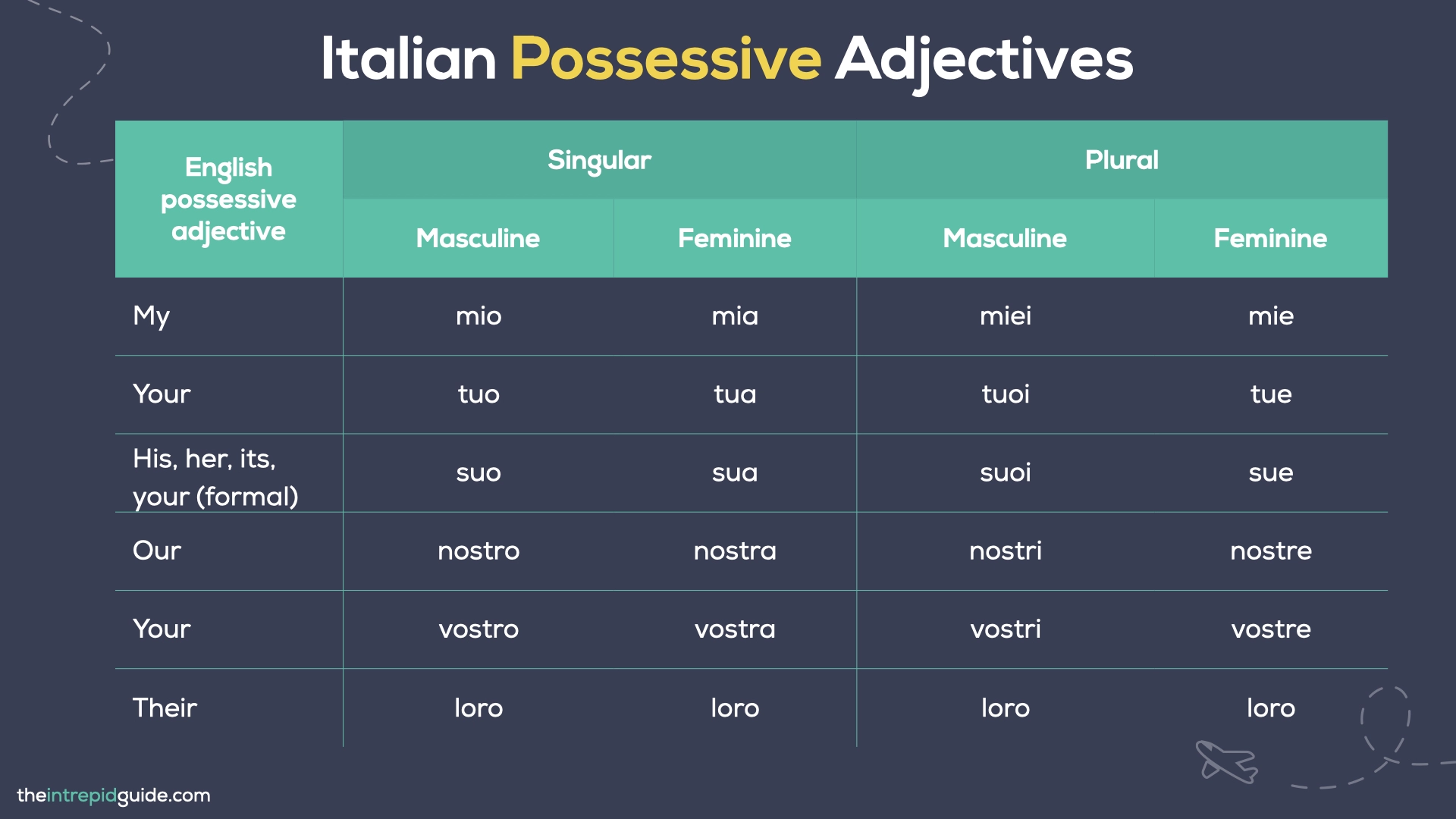Ah, la lasagna di mia mamma non la batte nessuno! (Man, nobody can top my mom’s lasagna!). This passionate statement resonates deeply with Italians, capturing how much they value their family’s cooking traditions. But what’s the magic element that infuses such pride into these words? The answer lies in that tiny word, mia (my), a possessive adjective expressing possession and belonging.
Possessive adjectives are key elements of the language, helping us show who or what belongs to whom. Think of them as little linguistic labels, guiding us through the intricate maze of relationships and possessions – a vital aspect of learning Italian!
This guide will help you master Italian possessive adjectives in un batter d’occhio (in the blink of an eye). You’ll find lots of examples, essential grammar notes, and a fun quiz at the end to make sure you’ve got it down. But first, make sure to download your free PDF cheat-sheet, which includes a handy chart of Italian possessive adjectives and all the key points we’ll cover in this guide. Just enter your email below and I’ll send it to you straight away.
By the way, want to improve your Italian quickly and having fun doing it? I thought so! If you’re a beginner, I recommend Intrepid Italian, my comprehensive self-paced programme that teaches you through the power of my unique 80/20 method. The course covers everything you need to know as a beginner in Italian (including how to use Italian possessive adjectives). Join now for lifetime access and my 30-Day “Celebrate with a Spritz” money-back guarantee by clicking here.
Or if you’re already at the intermediate level, why not enrol in Intrepid Italian for Advanced Beginners (A2) or Intrepid Italian for Intermediates (B1), my more advanced programmes that helps you master the trickiest aspects of Italian grammar while as you edge closer to fluency in Italian.
What are possessive adjectives?
Possessive adjectives are a specific category of adjectives used to indicate ownership or possession of the noun they refer to. For instance, in the sentence Angela ha perso la sua borsa (Angela lost her bag), the word sua (her) functions as a possessive adjective, clarifying that the bag belongs to Angela.
These adjectives are also used to denote relationships between individuals. Like in the sentence Paolo e Andrea vivono nella vecchia casa dei loro genitori (Paolo and Andrea live in their parents’ old house), where the possessive adjective loro (their) connects Paolo and Andrea to the parents, showing they’re family.
Now, in English, we encounter these adjectives in eight forms (my, your, his/her/its, our, your, their), while – surprise, surprise – Italian offers a more nuanced range, which we are about to explore together.
What is the difference between Italian possessive adjectives and Italian possessive pronouns?
When indicating ownership, it’s crucial to distinguish between possessive adjectives and possessive pronouns. Although both express possession, they fulfill distinct grammatical functions. This differentiation becomes particularly significant in Italian, where possessive adjectives and pronouns share identical spellings, often raising a few eyebrows.
In essence, possessive adjectives precede a noun to specify the owner of the person or thing mentioned by that noun. On the other hand, possessive pronouns replace the noun to avoid redundancy. Take a look at this example:
- Il mio cane si chiama Artù (My dog is named Artù) – here mio (my) acts as the possessive adjective, referring to the noun cane (dog) to indicate that the dog belongs to me
- Come si chiama il tuo? (What’s yours called?) – here tuo (yours) is the possessive pronoun, eliminating the need to repeat cane (dog).
Now that we’ve clarified this aspect, let’s dive into the world of possessive adjectives in Italian and see how they do their thing in grammar! By the way, if you want to brush up Italian pronouns, check out this guide to Italian pronouns, especially the part about how to use Italian possessive pronouns.
Possessive Adjectives in Italian Chart
Let’s start our journey with this Italian possessive adjectives chart that you can refer to whenever you’re not sure which one to use:
| Italian Possessive Adjectives | ||||
|---|---|---|---|---|
| English possessive adjective | Singular | Plural | ||
| Masculine | Feminine | Masculine | Feminine | |
| My | mio | mia | miei | mie |
| Your | tuo | tua | tuoi | tue |
| His, her, its, your (formal) | suo | sua | suoi | sue |
| Our | nostro | nostra | nostri | nostre |
| Your | vostro | vostra | vostri | vostre |
| Their | loro | loro | loro | loro |
While in English, possessive adjectives agree with the owner, in Italian they agree in gender (masculine or feminine) and number (singular or plural) of the thing being possessed. Let’s clarify with an example:
- Italian: Ho dato un passaggio a Chiara perchè la sua macchina è dal meccanico – here, the possessive adjective sua (her) ends with -a because macchina (car) is feminine, regardless of Chiara, the owner, being a woman.
- English translation: I gave Chiara a ride because her car is at the mechanic’s – in English, we use the possessive adjective “her” because Chiara is a woman, not because “car” is feminine. If the car belonged to Alberto, we would write “his car” because Alberto is male.
An exception to this rule is the Italian possessive adjective for the third person plural (loro – their), which remains unchanged regardless of the gender or number of the noun it accompanies. For instance:
- il loro spazio (the space), where “spazio” is singular masculine
- la loro casa (their home), where “casa” is singular feminine
- i loro libri (their books), where “libri” is plural masculine
- le loro maestre (their teachers), where “maestre” is plural feminine
However, the lack of distinction between feminine or masculine possessors in Italian can lead to ambiguity in the third person singular. Let’s take a sentence like Paola ha incontrato Anna con suo marito (Paola met Anna with her husband): does suo (her) refer to Paola or Anna? To avoid confusion, in such instances one can say Paola ha incontrato Anna con il marito di lei (meaning Anna’s husband).
Another crucial aspect to consider is the Italian distinction between addressing someone informally (“dare del tu”) and formally (“dare del Lei”). In the formal form, you should use the possessive adjective in the third person singular (“suo”, “sua”, “suoi”, “sue” – always capitalized in writing). For example:
- Professor Rossi, mi è molto piaciuto il Suo discorso oggi – Professor Rossi, I really enjoyed your speech today
- Signora, aspetti, la aiuto con la Sua valigia – Madam, please wait, I’ll help you with your suitcase
How to position Italian possessive adjectives in a sentence
In Italian, possessive adjectives typically precede the noun they refer to:
- Non trovo la mia giacca, chi l’ha presa? – I can’t find my jacket, who took it?
- Ragazze, adoro il vostro stile! – Girls, I love your style!
- Anna e Paolo sono in vacanza con i loro figli – Anna and Paolo are on holidays with their kids
Naturally, there are some exceptions when the possessive adjective is placed after the noun, including:
In exclamatory or evocative expressions, such as:
- Figlio mio, non abbatterti! – Son, don’t get discouraged!
- Amica mia, come farei senza di te! – My friend, what would I do without you!
- Ragazzi miei, la vedo dura! – Guys, this is going to be tough!
When emphasizing the possessor/owner, for instance:
- Errore mio, scusa – My mistake, sorry
- Sono soldi suoi, decide lei come spenderli – It’s her money, she gets to choose how she spends it
- Sono questioni vostre, io non ne voglio sapere niente – It’s your business, I don’t want to know anything about it
In certain fixed expressions like:
- Sa il fatto suo – He/she knows his/her stuff
- Da parte mia – As for me
- In cuor suo – In his/her heart
- Di testa loro – Of their own mind
Using articles with possessive adjectives in Italian
In Italian, unlike in English, possessive adjectives are typically preceded by an article – usually the definite article, but sometimes also the indefinite. Here are some examples:
- Dov’è la tua macchina? – Where is your car?
- Le presento i miei genitori – Let me introduce you to my parents
- Ieri mi ha chiamato un tuo amico – Yesterday, one of your friends called me
- Hanno ricevuto una lettera da una loro amica – They received a letter from a friend of theirs.
However, when talking about family, things get a bit special:
Possessive adjectives preceding singular family member names do not require an article, except in the third person plural. Here are some examples:
Latua madre – Your mother (with the exception of mamma – mom, which can either include or omit the article: mia mamma è bellissima or la mia mamma è bellissima – my mom is beautiful)Ilsuo padre– Your father (with the exception of papà – dad, which can also include or omit the article: mio papà è speciale or il mio papà è speciale – my dad is special)Ilvostro zio – Your uncle- La loro nonna – Their grandmother
- Il loro cugino – Their cousin
If the possessive adjective precedes a singular family member name that’s used as a term of endearment (like sorellona – big sister, zietta – auntie, etc.) or is accompanied by a qualifying adjective (i.e. an adjective expressing a quality or feature), then an article is needed before the possessive adjective:
- La mia dolce zia – My sweet aunt
- Il mio caro nonno – My dear grandfather
- Il tuo fratellino – Your little brother
- La sua nonnina – My granny
When talking about plural family member names, possessive adjectives always require the definite article:
- Le mie nipoti – My nieces
- I loro nonni – Their grandparents
- I nostri fratelli – Our brothers
- Questi sono i miei cugini con i loro figli Andrea e Riccardo – These are my cousins with their kids, Andrea and Riccardo
Other ways to indicate possession: “proprio” and “altrui”
Italian grammar adds an intriguing twist with two additional forms of possessive adjectives: proprio (own) and altrui (of someone else/of others).
Proprio (along with its variants propria, propri, proprie) can replace the possessive adjective of the third person singular or plural when the possessor is also the subject of the sentence. Here are some examples:
- Ogni studente deve portare il proprio portatile (Every student needs to bring their own laptop) – here, the laptop belongs to the subject of the sentence (ogni studente – every student).
- La prof ha chiesto a Maria di portare il
propriosuo portatile (The teacher asked Maria to bring her laptop) – in this case, the the laptop belongs to Maria, but the subject of the sentence is la prof (the teacher), so we can’t use proprio.
Proprio is particularly useful to avoid ambiguity and misunderstandings regarding ownership. For instance, in the sentence Laura ha parlato con Alessia del suo fidanzato (Laura spoke with Alessia about her boyfriend), one might wonder whose suo (her) is referring to. So, you could say Laura ha parlato con Alessia del proprio fidanzato (Laura spoke with Alessia about her own boyfriend), thereby clarifying that it’s Laura’s boyfriend.
Moreover, it is preferable to use proprio instead of the third person singular and plural possessive adjectives when using an impersonal construction or when the subject is indefinite (such as chiunque – anyone, tutti – everyone, etc.). For example:
- Ognuno ha i propri gusti – Everyone has their own tastes
- Tutti hanno le proprie opinioni – Everyone has their own opinions
- È importante riconoscere i propri limiti – It’s important to recognize one’s own limits
- Non si può pensare solo al proprio tornaconto – You can’t just think about what’s good for you
Altrui, on the other hand, means “of someone else” or “of others” and usually indicates an indefinite possessor/owner. It’s invariable and is only used when the possessor does not coincide with the subject. It is placed after the noun it refers to. For example:
- Non si devono giudicare le scelte altrui – One shouldn’t judge other people’s choices
- Bisogna rispettare l’opinione altrui – We should respect other people’s opinions
- Gestire i soldi altrui è una grande responsabilità – Managing other people’s money is a great responsibility
- Non si usano le cose altrui senza permesso! – You can’t use other people’s stuff without asking!
When to avoid using possessive adjectives
Now that we’ve explored how to use possessive adjectives in Italian, let’s see where it’s best to avoid them. Because, while undeniably handy, possessive adjectives aren’t always essential, and can lead to redundancy in communication. There are two main instances where you shouldn’t use them:
Do not use possessive adjectives In sentences featuring reflexive verbs. Reflexive verbs inherently imply that the subject is acting upon themselves, therefore, including a possessive adjective would be redundant:
- Mi pettino i capelli (literally, I’m combing myself the hair) – with the reflexive verb pettinarsi (to comb oneself), it’s already implicit that the hair being combed belongs to the subject. Thus, saying mi pettino
i mieicapelli (I comb myself my hair) is unnecessary. - Mi lavo la faccia (literally, I wash myself the face) – here, the reflexive verb lavarsi (to wash oneself) already conveys ownership, making mi lavo la
miafaccia (I wash myself my face) redundant.
Unlike English, where body parts are typically indicated with possessive adjectives (my head, my leg, my arm etc.), Italian employs the definite article instead:
- Non riesco a tenere gli occhi aperti (I can’t keep my eyes open – lit. I can’t keep the eyes open)
- Mi fa male la testa (My head hurts – lit. The head hurts)
How well do you know possessive adjectives in Italian? Take the quiz!
Put your knowledge to the test with this fun quiz!
If you found this lesson powerful, then you’ll love Intrepid Italian, my series of online self-paced video courses that break down everything you need to know about Italian using my 80/20 method. Visit IntrepidItalian.com for more details.
 Are you a beginner or an intermediate Italian learner? Got a trip coming up or want to communicate with your Italian partner or relatives in Italian? Learn Italian with my unique 80/20 method
Are you a beginner or an intermediate Italian learner? Got a trip coming up or want to communicate with your Italian partner or relatives in Italian? Learn Italian with my unique 80/20 method
Registrations are now open to join Intrepid Italian, my new series of online video courses that use my unique 80/20 method. You’ll go from a shy, confused beginner to a proficient and confident intermediate speaker, with me as your trusty guide.
You’ll finally be able to connect with your Italian partner, speak to your relatives and enjoy authentic travel experiences in Italy that you’ve always dreamed of, and so much more.
As a native English speaker who learned Italian as an adult, I know what it’s like to feel hopeless and lack the confidence to speak. I know what it’s like to start from scratch and to even go back to absolute basics and learn what a verb is!
Intrepid Italian was created with YOU in mind. I use my working knowledge of the English language to help you get into the ‘Italian mindset’ so you can avoid the common pitfalls and errors English speakers make – because I made them once too! I break everything down in such a way that it ‘clicks’ and just makes sense.
No matter what your level is, there is an Intrepid Italian course for you, including:
- 🇮🇹 Intrepid Italian for Beginners (A1)
- 🇮🇹 Intrepid Italian for Advanced Beginners (A2)
- 🇮🇹 Intrepid Italian for Intermediates (B1)
You can join 1, 2, or all 3 courses, it’s entirely up to you. The best part is that you have lifetime access so you learn anytime, anywhere and on any device.
As your guide, I walk you through each lesson, step-by-step, using my unique 80/20 method. My approach is different from traditional methods because I teach you the most important 20% of the language right from the beginning so you can start to speak straight away.
Each course includes video lessons, audio exercises, downloadable worksheets, bonus guides, a private support community, and lifetime access all designed to streamline your learning while having fun.
It even comes with my famous “Celebrate with a Spritz Guarantee”. After 30 days of using Intrepid Italian, if you don’t want to celebrate your new-found Italian skills with an Aperol Spritz, you don’t have to pay a penny! Cheers! 🥂
Join Intrepid Italian here and start learning today!
Ci vediamo lì! (See you there!)
Learning Italian? Check out these Italian language guides
- Italian for Beginners | How to Learn Italian in 3 Simple Steps
- TOP 100 Most Common Italian Words (Plus PDF Cheat-Sheet & Quiz)
- Italian Prepositions:The Only Guide You’ll Ever Need (PLUS Chart)
- 17 Weird Italian Superstitions Italians ACTUALLY Live By
- 17 Must-Know Italian Hand Gestures: The Ultimate Guide
- 10 Ways Natives REALLY Say ‘You’re Welcome’ in Italian
- How to say ‘Please’ in Italian in 9 Ways Like a Native
- 41 Italian Greetings: How to Say ‘Hello’ in Italian Like a Local
- 125 Most Common Italian Phrases for Travel You’ll Ever Need [PLUS Printable]
- 8 DEADLY mistakes in Italian (& How to Avoid Them)
- How to Conjugate Italian Verbs in 3 Simple Steps [Italian for Beginners]
- Is Italian Hard to Learn? 7 Common Mistakes & How to Avoid Them
- Master Days of the Week in Italian (7 Simple Memory Hacks)
- Italian Numbers: How to Count in Italian From 0 to 1 Billion (Plus PDF Download)
- How to Order Food & Drinks in Italian [Italian for Beginners]
- 15 Italian Words You Should NEVER Mispronounce [& How Not To]
- 11 Effective Hacks That’ll Help You Learn Italian So Much Faster
- Top 14 Italian Words You Should NEVER Say [& What to Use Instead]
- 20 Hilarious Everyday Italian Expressions You Should Use
- Romanesco: 25 Cool Roman Dialect Words You Should Use in Rome
- 10 Reasons Why Learning Italian Will Change Your Life
- 10 Italian Expressions Italians Love Saying
- 10 Italian Phrases That Will Instantly Make You Sound more Italian
- Funny Italian Sayings: 26 Food-Related Insults You Won’t Forget
- 15 Romantic Italian Films That’ll Make You Love Italy Even More
- How to Master Common Italian Phrases for Travel (Like a Local!)
Like it? Pin it for later!
Over to you!
Did you enjoy this lesson? Do you have a question? Let me know using the comments section below or join me on social media @intrepidguide or @intrepiditalian to start a conversation.
Thanks for reading and I hope you enjoyed this post.
Like what you see? Subscribe using the form below to have all of my posts delivered directly to your email.




